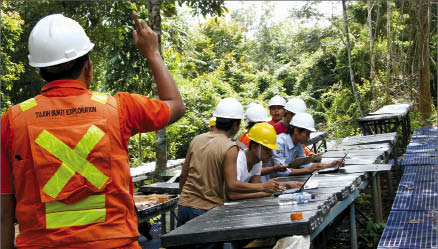For the third time in a little over a year, Australia-based Intrepid Mines (IAU-T, IAU-A) has added hundreds of millions of inferred tonnes at the Tujuh Bukit gold-copper project in Indonesia.
The resource increases have come from the Tumpangpitu sulphide target, which sits under a sizeable oxide resource, while the whole 116-sq.-km project sits in the southeast corner of the island of Java.
With the latest update Tumpangpitu is estimated to contain 1.7 billion inferred tonnes grading 0.41% copper and 0.46 gram gold per tonne for 15 billion lbs. copper and 25 million oz. gold, based on a 0.2% copper cut-off. The update adds over 70% to the 990-million-tonne resource released in May and is more than three times the 500-million-tonne resource released last September.
The resource’s footprint has increased correspondingly, from a 1.4-km diameter with the first resource to a 2.4-by-1.4-km area with the second. Now the resource spans 3.4-by-2.8-km, with a vertical depth of 1.1 km.
The resource is based on 41 drill holes – each over 700 metres long – for 36,600 metres of drilling. Five other holes did not hit the porphyry body. Previous resource estimates were based on 26 and 13 holes, respectively.
Meanwhile, sitting above the porphyry resource is a 130-million-tonne inferred gold-silver oxide resource grading 0.55 gram gold and 18 grams silver per tonne, for 2.4 million oz. gold and 80 million oz. silver. An April preliminary economic assessment on a potential heap-leach, open-pit operation for the oxide portion set a net present value of US$180 million with a 10% discount, a 31% internal rate of return using US$1,050 per oz. gold and a nine-year mine life producing 143,000 oz. per year at US$376 per oz. gold.
According to a June technical report, the overall mineralizing system broadly comprises a deep, magnetic tonalite body that has intruded into an older and more extensive feldspar-hornblende diorite stock. The shallow epithermal section is dominated by intense hydrothermally altered andesitic lithic volcanic breccias, diatreme breccias, hydrothermal breccias and diorite, while deeper portions are characterized by alteration and vein assemblages characteristic of porphyry systems.
Both the oxide and sulphide deposits, however, are located in designated protected forest land, which restricts some activities and bans open-pit mining. Intrepid, along with its local joint-venture partner, are applying to reclassify or rezone the land, but it is unclear how long the process will take, or if it will ever be successful.
The company is advancing the project despite this risk, and will soon have 11 drill rigs on site conducting infill and exploration drilling, with one capable of drilling down almost 2 km. The company is also advancing its Canadian porphyry target 2 km east of Tumpangpitu, and its Gunung Manis epithermal gold target 4 km east. The Gunung camp and drill rig were damaged by fires set by artisanal miners in June, but exploration has since resumed.
Before 2009, Indonesian mining laws did not allow foreign ownership of mining tenements, and Intrepid does not actually hold a direct interest in the Tujuh Bukit project. Instead, it has an 80% “economic interest” in the project through several contracts, with local joint-venture partner PT Indo Multi Niaga holding the rights. Intrepid is working to establish direct ownership now that the laws have changed, but it will need government approval, and possibly approval from the regency head of Banyuwangi as well as the Ministry of Mines and the investment board. Intrepid has noted that the regency head “Bupati” has also requested consultations about a future divestment of a minority stake in the project for local community benefits.
Vale (VALE-N) came close to optioning 60% of the sulphide portion of the project in 2009 for a US$40-million spending commitment, but the deal fell through. At the time, the project did not have an established sulphide resource.
Intrepid’s share price climbed 20¢ to $1.51 with 1.3 million shares traded on the latest resource update. The company hit a brief 52-week share price high of $2.45 in April and a low of 84¢ in October.
The company had almost $160 million cash-on-hand at the end of September. Intrepid sold off its Paulsens gold mine in Australia for A$40 milllion last year and its Casposo gold-silver mine in Argentina for US$22 million in 2009, as it increasingly focused on Tujuh Bukit. The company also raised $144 million in December 2010 after issuing 81 million shares in two separate financings. Now it has 522 million shares issued.


Be the first to comment on "Intrepid Mines keeps expanding Tumpangpitu"